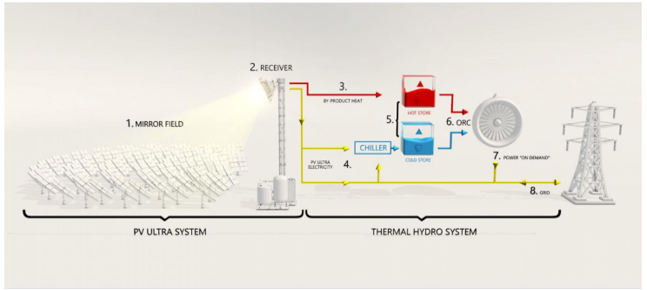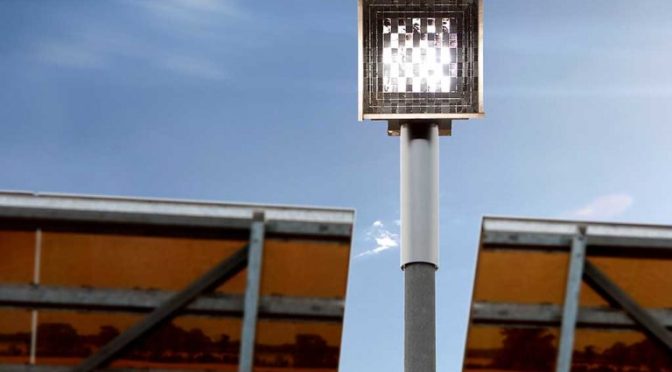An all-Australian hybrid solar energy and storage project promising cheap and dispatchable electricity is officially open for commercial-scale trials.
Combining incredibly efficient photovoltaic (PV) and low-cost thermal energy technologies, the new power plant will test Melbourne-based company RayGen’s unique approach to solar electricity generation and long-duration storage.
It’s the latest step, supported by ARENA, that has taken RayGen’s technology from a backyard shed to a 30-hectare site in Carwarp, north-western Victoria.
The test plant is designed to deliver 4 MW of solar PV generation and store 2.8 MW / 50 MWh (equivalent to 17 hours) of dispatchable energy.
If successful, RayGen plans to build a utility-scale power plant with 200 MW solar capacity and 115 MW / 1.2 GWh of storage. That would be enough, on average, to power around 45,000 homes for more than 10 hours.
To help achieve that, ARENA has also announced $10 million in funding to RayGen for a $32.7 million project. It aims to improve RayGen’s designs, achieve cost reductions and conduct a basic and detailed front-end engineering design (FEED) study of the planned utility-scale project.
ARENA CEO Darren Miller said at the Carwarp plant opening: “This project is the culmination of a 10-year journey.”
“ARENA has now supported RayGen through six different projects with over $38 million of funding. This sixth project is to help scale this technology up to even another level,” he said.

How does RayGen’s technology work?
RayGen’s founder and now Executive Director Dr John Lasich has been interested in solar since the 1970s. Speaking on ARENA’s Rewired podcast, he said experimenting with solar cells in those days was regarded as akin to “witchcraft”.
“When I started looking at it in [Monash] university, people thought that was okay because it was research. But a lot of other people thought, ‘You know, this guy’s a bit crazy here.’”
“Back in about ‘75, we got some solar cells and did some initial tests. And we saw that by putting concentrated light onto those, we could actually increase the power by factors of hundreds of times.”
And that’s the basic concept. Mirrors, or heliostats track the sun and focus sunlight onto RayGen’s PV cells mounted on towers. The cells generate electricity up to 2000 times the power output of a conventional solar panel of the same size.
But that’s not the end of the story, because the concentrated rays also generate a lot of heat. In fact, roughly 60 per cent of the sun’s available energy at the PV cell ends up as heat.
Raygen’s design has transformed that challenge into an opportunity.
The Carwarp facility features two large, heat-insulated pools of water. Each pool is 15 to 20 metres deep and the size of a small farm dam. Together, they contain roughly the equivalent of nine Olympic-size pools of temperature-maintained water.
Heat energy from the solar towers’ cooling systems keeps one of the pools just below boiling at around 90 Celsius. Refrigerators use solar or off-peak electricity to maintain the other pool to near freezing.
That temperature difference can then be used to drive a heat-to-power engine, generating dispatchable base-load power to the grid.
Global implications

The fact that RayGen’s concentrated solar approach needs thousands fewer power PV cells than conventional solar panels has big implications.
In a world of challenging supply chains and China’s virtual monopoly on solar panel manufacturing, Dr Lasich says RayGen’s design offers an alternative.
“Our module manufacturing is governed by very different economic dynamics to those of solar panels,” he said.
“Our modules can be manufactured in Australia or any other place that is required. It’s a real change in the module manufacturing work.
“RayGen has developed the Goldilocks formula. We are bringing the right elements together to produce a high-performance solar generator and, at the same time, being low cost.”
The heat energy storage system also offers a simple solution, using established technologies and water.
Assistant Minister for Climate Change and Energy, Senator Jenny McAllister, speaking at the Carwarp plant opening event, said she believed the project “has real significance in terms of what’s going on globally”.
“We’ve got a role to play as a country because, as innovators, we punch above our weight.
“It’s true for our scientific organisations, but it’s also true for our government organisations, organisations like ARENA and the CEFC [Clean Energy Finance Corporation], which provide institutional support.
“Taking ideas out of the university into the commercial world and bringing you to a point where major investors can engage and get ready to take them to scale.”
ARENA has since 2012 supported more than 280 solar PV and solar thermal projects with total funding of over $1 billion.
In July 2023, ARENA announced a $541,640 grant to the Australian PV Institute to produce a Silicon to Solar study. ARENA also published a whitepaper, The Incredible ULCS: How Ultra Low-Cost Solar Can Unlock Australia’s Renewable Energy Superpower.
Andrew Webster


